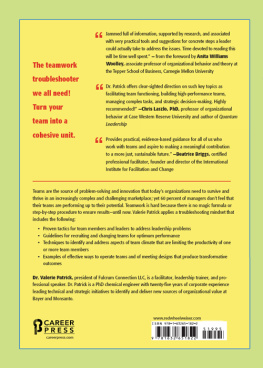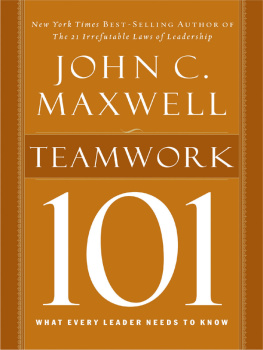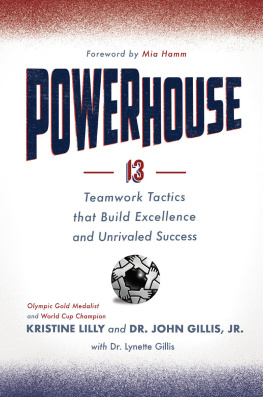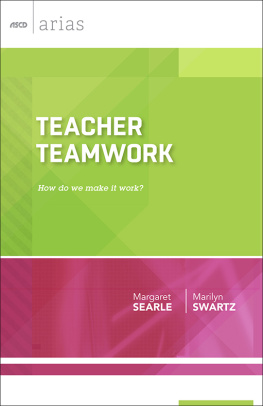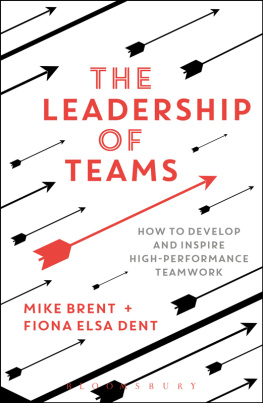
PRAISE FOR
When Bad Teams
Happen to Good People
Valerie Patrick takes all who want to run or be part of a high-functioning team but don't quite know the best formula to get there on a comprehensive but utterly readable journey of personal anecdotes, practical tools, and commonsense advice. When Bad Teams Happen to Good People is a must-have for anyone intent on at least trying to understand the challenges and get it close to right.
Nick Hamon PhD, CEO of IVCC
(Innovative Vector Control Consortium)
When Bad Teams Happen to Good People acts as a comprehensive reference manual for all who seek team-based productivity and satisfaction, being an equally compelling read for team leaders, members, designers, and facilitators. Valarie Patrick provides practical, integrative guidance for proactively bettering oneself, assembling great teams, designing engaging meetings, fostering positive outcomes, and identifying and addressing team dysfunction when it inevitably arises. Dr. Patrick conveys proven, structured methods for team improvement, backed by science and illuminated by meaningful experiences drawn from her years of experience as a business leader and facilitator.
Gary Fedder, PhD, Howard M. Wilkoff Professor of
Electrical and Computer Engineering at Carnegie Mellon University
This book outlines tools to develop revised teamwork models that can accommodate challenges associated with fast-changing times.
Dr. Devinder Mahajan, professor and graduate program director,
chemical and molecular engineering at Stony Brook University
Valerie Patrick combines deep insight with practical guidance based on her years of executive leadership in the corporate world. In the crowded field of team effectiveness, Dr. Patrick offers clear-sighted direction on such key topics as facilitating team functioning, building high-performance teams, managing complex tasks, and strategic decision-making. A highly readable book to help you grasp what is needed for greater self-care and self-awareness in today's business context, while giving you the practical skills and tools needed to fix bad teams and design great ones. Highly recommended!
Chris Laszlo, PhD, professor of organizational behavior at Case
Western Reserve University and author of Quantum Leadership
When
Bad Teams
Happen
to Good People
Your Complete Repair Guide
for Successful Teamwork
VALERIE PATRICK, PhD
Foreword by Anita Williams Woolley

This edition first published in 2021 by Career Press, an imprint of
Red Wheel/Weiser, LLC
With offices at:
65 Parker Street, Suite 7
Newburyport, MA 01950
www.careerpress.com
www.redwheelweiser.com
Copyright 2021 by Valerie Patrick
Foreword copyright 2021 by Anita Williams Woolley
All rights reserved. No part of this publication may be reproduced or transmitted in any form or by any means, electronic or mechanical, including photocopying, recording, or by any information storage and retrieval system, without permission in writing from Red Wheel/Weiser, LLC. Reviewers may quote brief passages.
ISBN: 978-1-63265-182-2
Library of Congress Cataloging-in-Publication Data available upon request.
Cover design by Kathryn Sky-Peck
Cover illustration by TanyaJoy/iStock.com
Interior by Timm Bryson, em em design, LLC
Typeset in Adobe Garamond Pro
Printed in the United States of America
IBI
10 9 8 7 6 5 4 3 2 1
www.redwheelweiser.com/newsletter
CONTENTS
FOREWORD
In every sector of our society, the need for teamwork is increasing because the complexity of the problems we face is increasing. And yet, as Valerie Patrick points out in the very first sentence of her book... teamwork is hard. It's hard because so many of us lack the basic wiring, awareness, and behaviors to interact with others in ways that enable productive teamwork to take shape. But do not despair, because with this book in hand, you will be armed with information and practical tools to help you remedy some of these shortcomings and improve your team's work.
Because of my research on collective intelligence and my role in teaching the next generation of leaders how to manage their teams, I typically read any new book that promises to provide important insights on this topic. And I have to admit I am frequently disappointed by the lack of content in such books; often, there is really just one main idea, one nugget, that is expanded upon and elaborated with war stories for two hundred pages, and I'm left feeling like a short article in a business publication would have been sufficient to get the key points. Not so with this bookthis book is literally jammed full of information, supported by research and accompanied by very practical tools and suggestions for concrete steps a leader could actually take to address the issues. As I read each chapter, I wrote down many notes and page numbers for sections I wanted to go back to and follow up on and think about how to integrate into my teaching. And as I read through the book, I would often think Oh, this is my favorite chapter but then I'd get to the next one, and I would like it just as much if not more! I . So many of the core problems of team design and collaboration are on display in meetings; it's a place where so much time gets wasted in so many organizations, and yet very few leaders are ever educated on how to design and run them well.
There is a lot of wisdom throughout this book, and much of it goes well beyond just fixing teams. It will make you think about your purpose, look after your own well-being, and get acquainted with your personality, strengths, and weaknesses. These are insights that will be valuable in all areas of life, including teamwork. Time devoted to reading this book will be time well spent, and it's one you will want to keep to go back to and reference again and again.
Anita Williams Woolley, associate professor
of organizational behavior and theory,
Tepper School of Business, Carnegie Mellon University
INTRODUCTION
Why Do Bad Teams Happen to Good People?
Bad teams happen to good people because teamwork is hard. Can you imagine applying what you learned about social interactions from your family to the workplace? I grew up with three brothers, so my take would go something like this: Tim looks like he can punch hard, so I'm going to be nice to Tim and not say anything to provoke him. Jonathan is someone I can get to do work for me, and Matthew needs my guidance. Not only would it be unfair to judge Tim, Jonathan, and Matthew through the lens of my brothers, but it also would be unprofessional and ineffective to talk and behave according to these preconceptions. Teamwork is hard because social skills learned in one situation may or may not apply to another situation. In fact, research finds that 75 percent of workplace teams are dysfunctional because they fail to meet three or more of five measures of team performance. So bad teams happen to good people because there are more bad teams than good teams in organizations.
Teamwork is harder today than at any other point in history because of the diversity of team members. For example, most workplaces have four to five generations of employees, which include the following: Traditionalists born before 1946, Baby Boomers born between 1946 and 1964, Generation X born between 1965 and 1976, Generation Y or Millennials born between 1977 and 1997, a 72 percent increase in five years! Interacting with siblings and school friends is easier than interacting with people who have different values, look different, and have a different major.
Next page
